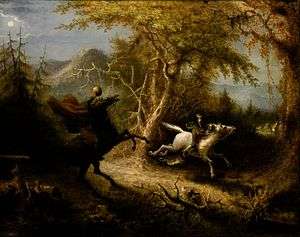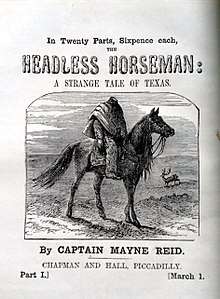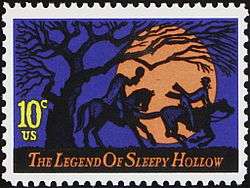Headless Horseman

The Headless Horseman has been a motif of European folklore since at least the Middle Ages.[1] The Headless Horseman is traditionally depicted as a man upon horseback who is missing his head. Depending on the legend, the Horseman is either carrying his head, or is missing his head altogether, and is searching for it. Perhaps the most famous myth arises from the short story "The Legend of Sleepy Hollow," written in 1820 by Washington Irving.
In American folklore

The Headless Horseman is a fictional character from the short story "The Legend of Sleepy Hollow" by American author Washington Irving. The story, from Irving's collection of short stories entitled The Sketch Book of Geoffrey Crayon, Gent., has worked itself into known American folklore/legend through literature and film.
The legend of the Headless Horseman begins in Sleepy Hollow, New York, during the American Revolutionary War. Traditional folklore holds that the Horseman was a Hessian artilleryman who was killed during the Battle of White Plains in 1776. He was decapitated by an American cannonball, and the shattered remains of his head were left on the battlefield while his comrades hastily carried his body away. Eventually they buried him in the cemetery of the Old Dutch Church of Sleepy Hollow, from which each Halloween night he rises as a malevolent ghost, furiously seeking his lost head.[2]
The Headless Horseman is also a novel by Mayne Reid, first published in monthly serialized form during 1865 and 1866, and subsequently published as a book in 1866,[3][4] based on the author's adventures in the United States. "The Headless Horseman" or "A Strange Tale of Texas" was set in Texas and based on a south Texas folk tale.
In Irish folklore
The dullahan or dulachán ("dark man") is a headless, demonic fairy, usually riding a horse and carrying his head under his inner lower thigh (or holding it high to see at great distance). He wields a whip made from a human corpse's spine. When the dullahan stops riding, a death occurs. The dullahan calls out a name, at which point the named person immediately dies.[5] In another version, he is the headless driver of a black carriage.[6] A similar figure, the gan ceann ("without a head"), can be frightened away by wearing a gold object or putting one in his path.[7]
In British folklore
The most prominent British tale of the headless horseman concerns a man named Ewen decapitated in a clan battle at Glen Cainnir on the Isle of Mull. The battle denied him any chance to be a chieftain, and both he and his horse are headless in accounts of his haunting of the area.[8]
The 14th century poem Gawain and the Green Knight features a headless horseman, the titular giant knight. After he is beheaded by Gawain the Green Knight lifts his head up with one hand and rides from the hall, challenging Gawain to meet him again one year later.[9]
In German folklore
The German Legends of the Brothers Grimm (Deutsche Sagen) recount two German folk tales of a headless horseman being spotted with their own eyes.
One is set near Dresden in Saxony. In this tale, a woman from Dresden goes out early one Sunday morning to gather acorns in a forest. At a place called "Lost Waters", she hears a hunting horn. When she hears it again, she turns around and she sees a headless man in a long grey coat sitting on a grey horse.
In another German tale, set in Brunswick in Lower Saxony, a headless horseman called "the wild huntsman" blows a horn to warn hunters not to ride the next day, because they will meet with an accident.
In some German versions of the headless horseman, he seeks out the perpetrators of capital crimes. In others, he has a pack of black hounds with tongues of fire.
In Indian folklore
The jhinjhār is a headless horseman found in the folklore of Rajasthan and Madhya Pradesh. Unlike European depictions, this headless horseman is often portrayed as a heroic figure; folklore states that jhinjhārs are said to be born out of violent and wrongful deaths that occur in protecting innocents. Most stories about the jhinjhār describe it as a Rajput prince who lost its head while defending a village or caravan from bandits but refusing to back down even after being beheaded, while other versions describe it as a Mughal cavalryman trying to defend its prince.
In popular culture

Comics
The comic book series Chopper, written by Martin Shapiro, is a modern-day reimagining of the headless horseman. It features a headless outlaw biker on a motorcycle who collects the souls of sinners. The only people who can see him are those who have consumed a strange new Ecstasy-like drug that triggers their sixth sense and opens a gateway to the afterlife. During the hallucinogenic high, any characters who have committed significant sins are hunted by the headless ghost. Once the drug wears off the victim is safe and beyond the headless horseman's ghostly reach.[10][11][12]
Television
The Kolchak: The Night Stalker episode "Chopper" (initially broadcast on January 31, 1975)[13] features a headless motorcyclist who enacts revenge for the loss of his head on a rival biker gang,[14][15] 20 years after his murder.[16]
In the Midsomer Murders episode "The Dark Rider", a killer lures several victims to their deaths by masquerading as a headless horseman from local legend.[17]
See also
- cephalophore, beheaded Christian martyred saints
- Saints Gemolo and Himerius of Bosto
- Headless Mule, a character in Brazilian folklore
- List of ghosts
- List of ghost films
- Headless men
Notes
| Wikimedia Commons has media related to Headless horseriders. |
- ↑ "Headless Horseman". Mythical Creatures Guide.
- ↑ Steiner, Henry John (24 January 2014). "A Phantom is Born? 235 Years Ago". River Journal. Tarrytown, NY: River Journal Inc. Retrieved 14 October 2011.
- ↑ Sutherland, John (2013). The Longman Companion to Victorian Fiction (second ed.). Abingdon, Oxon.: Routledge. ISBN 9781408203903.
- ↑ Reid, Mayne (1866). The Headless Horseman: A Strange Tale of Texas. London: Richard Bentley.
- ↑ The Dullahan – Ireland's Headless Horseman at Scary For Kids
- ↑ The Dullahan at Shee-eire.com
- ↑ McKillop, James A Dictionary of Celtic Mythology, 2004, cited at gan ceann, encyclopedia.com
- ↑ Fox, David The Headless Horseman at Federated Caledonian Societies South Africa
- ↑ https://en.wikisource.org/wiki/Sir_Gawain_and_the_Green_Knight_(Neilson_translation)
- ↑ Shapiro, Martin (2011). Chopper. Asylum Press. ISBN 978-1-61724-110-9.
- ↑ "Chopper". ComicBookDB.com. Retrieved 2013-03-11.
- ↑ "New Chopper Comics Series". Fangoria.com. Archived from the original on 2013-04-10. Retrieved 2013-03-11.
- ↑ "Kolchak: The Night Stalker Episode Guide 1975 Season 1 - Chopper, Episode 15". TVGuide.com. Retrieved 2014-02-18.
- ↑ Stephen King. Danse Macabre. Retrieved 2014-02-18.
- ↑ TV.com. "Kolchak: The Night Stalker - Season 1, Episode 15: Chopper". TV.com. Retrieved 2014-02-18.
- ↑ John Kenneth Muir. Terror Television: American Series, 1970-1999. Retrieved 2014-02-18.
- ↑ "The Dark Rider". Midsomer Murders. Retrieved 2014-02-18.